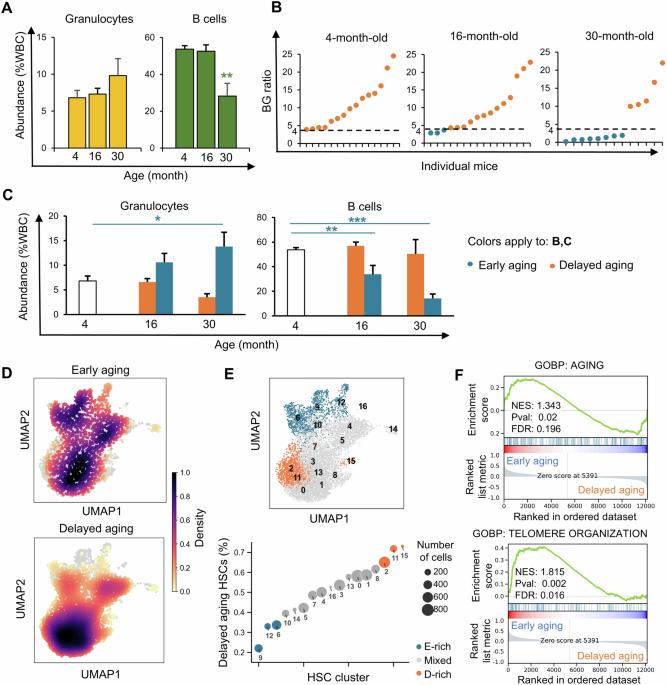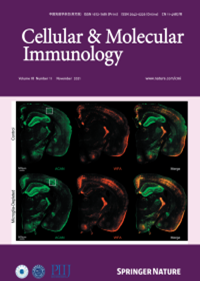与年龄相关的免疫细胞再生失衡现象因人而异,并由不同的干细胞亚群引起。
IF 21.8
1区 医学
Q1 IMMUNOLOGY
引用次数: 0
摘要
与年龄相关的免疫力下降表现为适应性免疫细胞和先天性免疫细胞的失衡,而这种失衡源于维持免疫细胞再生的干细胞的衰老。个体间的衰老差异已得到公认,但其机制仍不清楚。在这里,我们利用高通量单细胞技术比较了同一年龄段的小鼠表现出的早期或延迟免疫衰老表型。我们发现,早期衰老小鼠的一些造血干细胞(HSCs)上调了与衰老、骨髓分化和干细胞增殖相关的基因。延迟衰老则与涉及干细胞调节和对外部信号反应的基因有关。这些分子变化与造血干细胞功能的转变相一致。我们发现,随着年龄的增长,30%至40%的造血干细胞克隆的系偏向发生了变化。此外,在表现出早期衰老或延迟衰老表型的小鼠中,它们的系偏向发生了相反的转变。在早期衰老小鼠中,造血干细胞系偏向于髓系,从而导致衰老表型。而在延迟衰老的小鼠中,造血干细胞系偏向淋巴系,从而有效抵消了衰老进程。此外,抗衰老造血干细胞克隆并没有增加淋巴细胞的生成,反而减少了骨髓细胞的生成。此外,我们还系统地量化了造血干细胞分化中各种变化的频率及其在驱动免疫衰老表型中的作用。综上所述,我们的研究结果表明,个体间免疫细胞再生衰老的时间差异主要源于不同造血干细胞亚群骨髓造血功能的差异。因此,针对干细胞亚群进行干预,可能会延缓衰老。本文章由计算机程序翻译,如有差异,请以英文原文为准。

Age-associated imbalance in immune cell regeneration varies across individuals and arises from a distinct subset of stem cells
The age-associated decline in immunity manifests as imbalanced adaptive and innate immune cells, which originate from the aging of the stem cells that sustain their regeneration. Aging variation across individuals is well recognized, but its mechanism remains unclear. Here, we used high-throughput single-cell technologies to compare mice of the same chronological age that exhibited early or delayed immune aging phenotypes. We found that some hematopoietic stem cells (HSCs) in early aging mice upregulated genes related to aging, myeloid differentiation, and stem cell proliferation. Delayed aging was instead associated with genes involved in stem cell regulation and the response to external signals. These molecular changes align with shifts in HSC function. We found that the lineage biases of 30% to 40% of the HSC clones shifted with age. Moreover, their lineage biases shifted in opposite directions in mice exhibiting an early or delayed aging phenotype. In early aging mice, the HSC lineage bias shifted toward the myeloid lineage, driving the aging phenotype. In delayed aging mice, HSC lineage bias shifted toward the lymphoid lineage, effectively counteracting aging progression. Furthermore, the anti-aging HSC clones did not increase lymphoid production but instead decreased myeloid production. Additionally, we systematically quantified the frequency of various changes in HSC differentiation and their roles in driving the immune aging phenotype. Taken together, our findings suggest that temporal variation in the aging of immune cell regeneration among individuals primarily arises from differences in the myelopoiesis of a distinct subset of HSCs. Therefore, interventions to delay aging may be possible by targeting a subset of stem cells.
求助全文
通过发布文献求助,成功后即可免费获取论文全文。
去求助
来源期刊
CiteScore
31.20
自引率
1.20%
发文量
903
审稿时长
1 months
期刊介绍:
Cellular & Molecular Immunology, a monthly journal from the Chinese Society of Immunology and the University of Science and Technology of China, serves as a comprehensive platform covering both basic immunology research and clinical applications. The journal publishes a variety of article types, including Articles, Review Articles, Mini Reviews, and Short Communications, focusing on diverse aspects of cellular and molecular immunology.

 求助内容:
求助内容: 应助结果提醒方式:
应助结果提醒方式:


